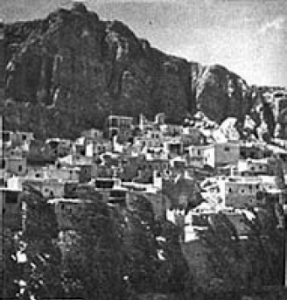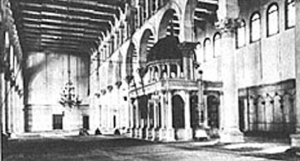Part II: Religions of the Arabs
Chapter 3: Monotheism: Judaism, Christianity, and Islam
While Arabs trace their racial origins to the homogenous geneologies of three continents, they trace their religious ancestry back to one place and one man.
About two thousand years before Christ a man out of Ur of the Chaldees (Iraq) in the Mesopotamian Plain set out to make his way to the land of Canaan. His name was Abraham and with him was his Syrian wife, Sarai, and his clan of about three hundred people, among them his nephew Lot, son of Haran. They travelled through the Euphrates Valley to Aleppo and from Aleppo to the mountains of Anti-Lebanon. They passed through Damascus, crossed the Syrian Desert to the Jordan River, went into the Valley of Shechem, and into Hebron. In Canaan, Abraham and his people dug wells and erected altars to El, the Supreme Creator.
In a time of great famine, Abraham took his wife and family and went into Egypt where they were well received and prospered, becoming rich in livestock, silver and gold. While in Egypt, Sarai acquired a maid servant, Hagar. During the tenth year of their life in Canaan, Sarai, who was barren, in a moment of feminine generosity, offered her maid servant to Abraham to bear him sons. Abraham was quick to accept the offer.
Hagar’s pregnancy made Abraham’s household less than harmonious. Hagar, proud of an accomplishment denied to Sarai, looked upon her mistress “with disdain,”[1] and Sarai, angered by Hagar’s ingratitude and Abraham’s indifference to the squabbling of women, abused Hagar, who then ran away.
We are told in the Old Testament, “The Lord’s Messenger found her by a spring in the wilderness, the spring on the road to Shur,”[2] and he asked her, “Hagar, maid of Sarai, where have you come from and where are you going?” She answered, “I am running away from my mistress, Sarai.” But the Lord’s Messenger told her, “Go back to your mistress and submit to her abusive treatment.”[3] She was then told that the Lord would make her descendants so “numerous that they will be too many to count.”[4] “You shall bear a son,” she was told, “and you shall name him, Ishmael.”[5]
When Ishmael was fourteen years of age and his father one hundred, Sarai,[6] in her old age, bore Abraham a son. On the day of the child’s weaning feast, Sarai noticed Ishmael, the son of the Egyptian, Hagar, playing with the small child, Isaac. She demanded of Abraham that he drive out the woman and her son, and Abraham, tired of the female bickering, capitulated to her wishes.
Thus, say the Arabs, it all began with Father Abraham. Of the Semites who dwelt in the land of Canaan, some embraced the God of Moses, and later followed Jesus throughout the cities and towns, the green fields and flowering hillsides of Palestine. Other Semites were those who were sent away by Father Abraham into the deserts which he, himself, had crossed long years before on his journey to Canaan. From these children of Ishmael, son of Abraham, came Muhamed, “the chosen of God.”
Thus, all three of the major religions of the Middle East had a common origin. The teachings of the first, Judaism were assimilated with the teachings of the second, Christianity. The first Christians were those Semites of Abraham’s seed who chose, over the old Judaism, the new concept of brotherly love and the Messiah’s instructions to “Treat others the way you would have them treat you.”[7] They believed with Christ in giving Caesar his due, and the Lord His due, thus advocating for the first time in man’s history, the separation of religion from the state. Among them were Mary, the Virgin, the first to follow the teachings of her son, and Elizabeth, her cousin, the Mother of John the Baptist who went before the Messiah heralding his coming. The Canaanite woman living in the locality of the Tyre and Sidon in Lebanon became a Christian when Jesus cured her daughter of being possessed by demons. Simon, the Son of Jonah, became Peter, the rock to whom Jesus entrusted the Keys to the Kingdom.
These Semites, converted by the Master Himself, were the first among the Christians, and they went into the land of Canaan, into Antioch, and throughout Asia Minor to spread the Christian word. Mark, the Apostle, carried the new religion into Egypt, and the Coptic Church of Egypt today descends in an unbroken line from the Church which St. Mark began. These Christians carried the Cross into Ethiopia, to Cyprus, Athens, Thessalonica, Corinth, and into the remote and hazardous wildernesses of Europe. They suffered persecution, torture and death for this new belief, and in Phoenicia, Palestine and Syria, they went to desperate lengths to worship in their new faith. From all the eastern countries which were then under the heel of the Caesars, these early Christians went to Rome in chains, to martyrdom in the arenas, the amphitheaters and the Circus Maximus. They suffered, particularly in Palestine. At times, with their Jewish relatives, they were harrassed and interrogated by the Romans for their politics. At other times they suffered for their religion at the hands of the Sanheddrin, protectors of the Jewish law.



They preserved their religion through language. They clung to their customs, sang their songs, and worshiped in the Semitic and Aramaic dialects. Indeed, much of the religious literature, not only of the Christians, but that of the Jews as well, was written in Aramaic, also known as Syriac, and hidden away from the Romans to tell their histories one day to future generations. Actually, Aramaic was the lingua franca of Western Asia from the period of the Persian conquest in the 6th century B.C. until the Moslem conquest in the 7th century A.D.
While some of these early Arab Christians went into other lands, taking Christianity to the world, others stayed in Palestine, Syria, The Lebanon and Mesopotamia. They established churches in secret underground catacombs, and, later in the first century, they constructed the first church above ground.
The saints of those early years are known throughout the world. For example, there is St. George, patron of England; the Martyr, Theodosia of Tyre; Pamphilus of Beirut; Augustine of Hippo; Anthony of Egypt, founder of Christian monasticism; John Chrysostom of Constantinople, author of eastern liturgies; and Maron of Syria. The newest saint of the Eastern Christian church is Charbel Mahklouf, a Maronite monk of Lebanon who died late in the nineteenth century and was canonized by Pope Paul in October of 1977.
- Old Testament, New American Bible, Catholic Book Publishing Co., New York, NY, 1970 -- Genesis Chapter 16, Verse 4. ↵
- Ibid. Verse 7. ↵
- Ibid. Verse 9. ↵
- Ibid. Verse 10. ↵
- Ibid. Verse 11. ↵
- Old Testament, New American Bible -- Genesis Chapter 21. ↵
- New Testament, New American Bible -- Matthew, Chapter 7, Verse 12. ↵
